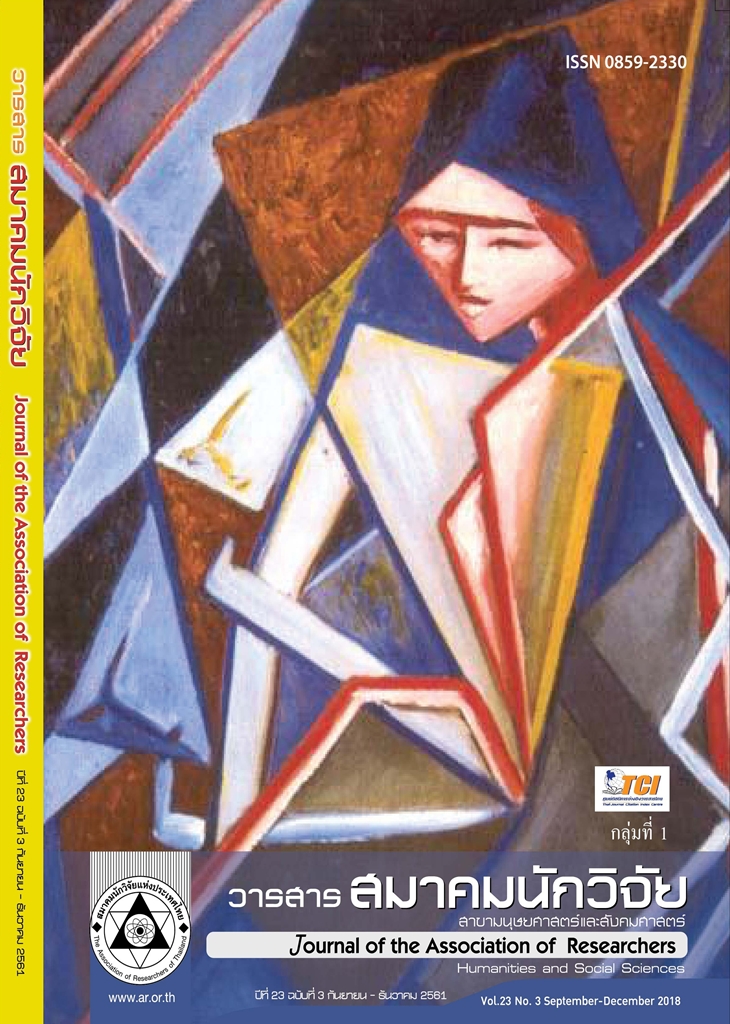Influence of Socially Responsible Leadership and Stakeholder’s Perception of Corporate Social Responsibility on Image of Electricity Generating Authority of Thailand: A Case Study of Thap Sakae Solar Power Plant, Prachuap Khiri Khan Province
Main Article Content
Abstract
The objectives of this research were 1. to study of structural relationship between socially responsible leadership, stakeholders’ perception of social responsible recognition of organization and image of Electricity Generating Authority of Thailand. 2. to study the influence of socially responsible leadership on stakeholders’ perception of social responsible recognition of organization 3. to study the influence of socially responsible leadership on image of Electricity Generating Authority of Thailand and indirect via stakeholders’ perception of social responsible recognition of organization and 4. to study the influence of stakeholders’ perception of social responsible recognition of organization on image of Electricity Generating Authority of Thailand. This research is quantitative research. A questionnaire was utilized as the tool in this research. Samples were people who live in Thab Sakae, Prachuap khiri khan Province and related persons. Use quota sampling, and completely sample size was 400. This paper used structural equation model to test hypotheses. The results found that 1. correlation coefficient among observable variables were 0.286 - 0.608 and every variable had a significant level. From structural equation modeling, it found that 2. socially responsible leadership had direct effect to stakeholders’ perception of social responsible recognition of organization at the statistical significance (DE = 0.77, p < 0.01) and variance predicted by socially responsible leadership with 60 percent, 3. socially responsible leadership had directly effect to image of Electricity Generating Authority of Thailand at the statistical significance (DE = 0.26, p < 0.01) and had indirect effect via stakeholders’ perception of social responsible recognition of organization at the statistical significance and variance predicted by socially responsible leadership with 61.40 percent, and 4. stakeholders’ perception of social responsible recognition of organization had effect to image of Electricity Generating Authority of Thailand at the statistical significance (DE = 0.56, p < 0.05). Fit indices of the model were X2 / df = 1.437, CFI = 1.00, NNFI = 0.99, RMSEA = 0.33 and 90% CI for RMSEA has value between 0.00 ; 0.055.
Article Details
บทความที่ปรากฏในวารสารนี้ เป็นความรับผิดชอบของผู้เขียน ซึ่งสมาคมนักวิจัยไม่จำเป็นต้องเห็นด้วยเสมอไป การนำเสนอผลงานวิจัยและบทความในวารสารนี้ไปเผยแพร่สามารถกระทำได้ โดยระบุแหล่งอ้างอิงจาก "วารสารสมาคมนักวิจัย"
References
จิรพรรณ รัตนจักร. (2557). ภาวะผู้นำที่รับผิดชอบต่อสังคมและวัฒนธรรมองค์การที่ส่งผลต่อการดำเนินงานด้านความรับ ผิดชอบต่อสังคมกลุ่มแอสซีจี เคมีคอลส์. วิทยานิพนธ์บริหารธุรกิจมหาบัณฑิต สาขาบริหารธุรกิจ, มหาวิทยาลัย เกษตรศาสตร์.
ธีรพร ทองขะโชค. (2556). “การใช้แบบจำลองสมการโครงสร้างในการศึกษาปัจจัยที่มีอิทธิพลต่อความรับผิดชอบต่อสังคม ของบริษัทจดทะเบียนในตลาดหลักทรัพย์แห่งประเทศไทย.” วารสารบริหารธุรกิจ 36 (140): 71-97.
พิพัฒน์ นนทนาธรณ์. (2559). การจัดการความรับผิดชอบต่อสังคมและองค์การ: การสร้างข้อได้เปรียบ ในการแข่งขัน อย่างยั่งยืน. พิมพ์ครั้งที่ 2. กรุงเทพมหานคร: ศูนย์ผู้นำธุรกิจเพื่อสังคม.มหาวิทยาลัยเกษตรศาสตร์.
_____________ (2558). “ปัจจัยเชิงสาเหตุของภาวะผู้นำที่รับผิดชอบต่อสังคมที่มีอิทธิพลต่อภาพลักษณ์องค์การของท่า อากาศยานสุวรรณภูมิ.” วารสารสมาคมนักวิจัย 20 (2): 48-58.
ระพีพรรณ วงศ์ประเสริฐ. (2553). ความรับผิดชอบต่อสังคมธุรกิจ. กรุงเทพมหานคร: มหาวิทยาลัยกรุงเทพ. สถาบันธุรกิจเพื่อสังคม. (2551). เข็มทิศธุรกิจเพื่อสังคม. กรุงเทพฯ: โรงพิมพ์ ไอคอนพรินติ้ง.
References
Astin, H. S. (1996). Leadership for social change. About Campus, 1(3), 4-10.
Carroll, A. B. (1991). “Corporate Social Responsibility: Evolution of a Definitional Construct more.” Business and Society 38(3): 268-295.
Hooper, D. J. Coughlan and M. R. Mullen. (2008). “Structural Equation Modeling: Guidelines for Determining Model Fit.” The Electronic Journal of Business Research Methods 6(1): 53-60.
Keller, K. L. (2003). Strategic Brand Management: Building, Measuring and Managing Brand Equity. 2nd ed. New Jersey: Prentice Hall.
Leech, N. L., K. C. Barrett, and G.A. Morgan. (2005). SPSS for Intermediate Statistics, Use and Interpretation. 2nd ed. New Jersey: Lawrence Erlbaum Associates.
Nonthanathorn, P. (2010). Corporate Social Responsibility Management: Creating Sustainable Competitive Advantage. Nonthaburi: Thinkbeyond. (in Thai).
Waldman, D. A. (2007). “Best Practices in Leading at Strategic Levels: A Social Responsibility Perspective.” In Jay A. C. and R. E. Riggio. (eds.). The Practice of Leadership. San Francisco: Jossey-Bass.
Translated Thai References
Nonthanathorn, Phiphat. (2010). Corporate Social Responsibility Management: Creating Sustainable Competitive Advantage. Nonthaburi: Thinkbeyond. (in Thai).
Working Committee of Social and Environment Promotion of Listed Company. (2008). Business Compass for Society. Bangkok: CSRi. (in Thai).


